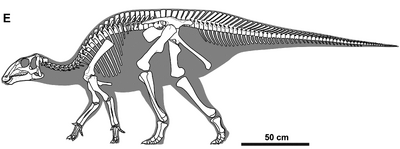| This page uses Creative Commons Licensed content from Wikipedia (view authors). |
| Gobihadros | |||
|---|---|---|---|

| |||
| General information | |||
| Universe | Real Life | ||
| Classification | Gobihadros mongoliensis | ||
| Species type | Hadrosaur | ||
| Homeworld | Earth | ||
| Intelligence | Non-sapient | ||
| Biochemistry | Carbon-based lifeform | ||
| Discovered | 2019 | ||
| Discoverer | Khishigjav Tsogtbaatar | ||
| Biological information | |||
| Reproduction | Sexual; Lays leathery eggs | ||
| Average length | Just under 10' (3 m) | ||
| Locomotion | Quadrupedal | ||
| Feeding behavior | Herbivorous | ||
| Lineage information | |||
| Cultural information | |||
| Alignment | Neutral | ||
| Organization | Herds (presumed) | ||
| Sociocultral characteristics | |||
| Scientific taxonomy | |||
| Planet | Earth | ||
| Domain | Eukaryota | ||
| Kingdom | Animalia | ||
| Subkingdom | Eumetazoa | ||
| Infrakingdom | Bilateria | ||
| Superphylum | Deuterostomia | ||
| Phylum | Chordata | ||
| Subphylum | Vertebrata | ||
| Infraphylum | Gnathostomata | ||
| Superclass | Tetrapoda | ||
| Class | Reptiles | ||
| Subclass | Archosauria | ||
| Infraclass | Avemetatarsalia | ||
| Superorder | Dinosauria | ||
| Order | Ornithischia | ||
| Suborder | Ornithopoda | ||
| Infraorder | Iguanodontia | ||
| Superfamily | Hadrosauroidea | ||
| Family | Hadrosauromorpha | ||
| Genus | Gobihadros | ||
| Species | mongoliensis | ||
| Other information | |||
| Status | Extinct | ||
| First sighting | 100.5 mya | ||
| Last sighting | 83.6 mya | ||
Gobihadros (Gobihadros mongoliensis) was a species of relatively small basal hadrosaurs indigenous to Mongolia during the Late Cretaceous Period. It is a closely related cousin to the hadrosauridae, but is not one of them.
Physiology[]
Gobihadros were similar to other hadrosaurs in that, via parallel evolution, they possessed a double-layered tomial edge of the premaxilla as well as the presence of as many as three teeth per tooth position in the lower jaw. However they differ from Bactrosaurus, Claosaurus, Eolambia, Probactrosaurus, and Tethyshadros in that they possessed an undulating upper profile of the ilium and a more sidewards-projecting supra-acetubular crest; they also differed from the likes of Plesiohadros, Tethyshadros, and the rest of the hadrosaurids in that they had a conical spike-like claw on the first finger.
Juveniles grew to a length of almost 10 feet (3 meters), though the exact length of an adult specimen are not currently known.
Background history[]
As of 2019, it is the most completely known basal Hadrosaur from the continent of Asia, where it affirmed a pattern of American hadrosauroid invasions during the Cretaceous as it differs significantly from later hadrosaurs in the area, indicating that American hadrosauroids drove Asian species to extinction.